Overwintering hibiscus plants indoors is easier than you might think, and there are 3 easy ways to do it.
In this guide, I’ll show you how to keep a hibiscus over the winter, and share the three most effective methods to do it so that you can enjoy them all year long.
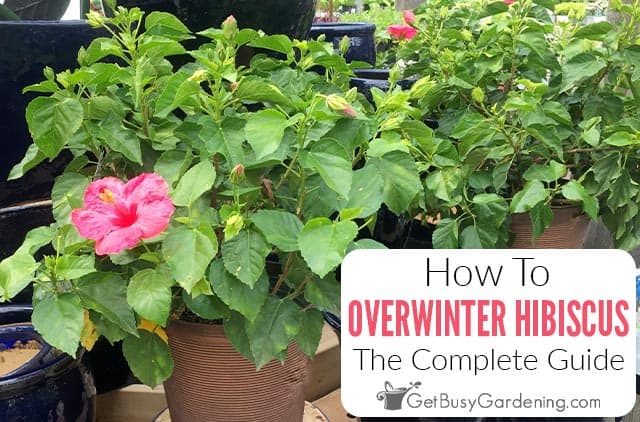
Tropical hibiscus is one of my favorite plants to overwinter inside. It’s really simple to do, and well worth the effort to save them.
It’s a huge money saver too, since they are expensive to buy every year. So, for me it’s a no-brainer to bring them in the house in fall, and move them back outside every spring.
Another reason I bring them indoors is because they’ll bloom all winter long in a sunny window. The bright, cheery flowers are a welcome sight when it’s freezing cold outside.
If you have a tropical hibiscus in your summer containers, and you’re wondering what to do with it in winter to keep it alive, then this article is for you.
Is Hibiscus Annual Or Perennial?
Though they’re sold at the garden center as annuals, tropical hibiscus are actually tender perennials that can easily be overwintered indoors.
The hardiness of the one you have depends on both the species and the climate you live in. There are a few hardier varieties that can survive outdoors down to zone 4.
But the ones sold in the tropical section won’t survive outside in cold climates. They’re only hardy in zones 10 and above.
Methods Of Overwintering Hibiscus
There are three ways to overwinter hibiscus. Choose your favorite method or the one that makes the most sense to you.
- Hibiscus can be brought inside and enjoyed as a houseplant
- They can be allowed to go dormant and stored for winter
- Cuttings can be rooted in water and replanted in spring
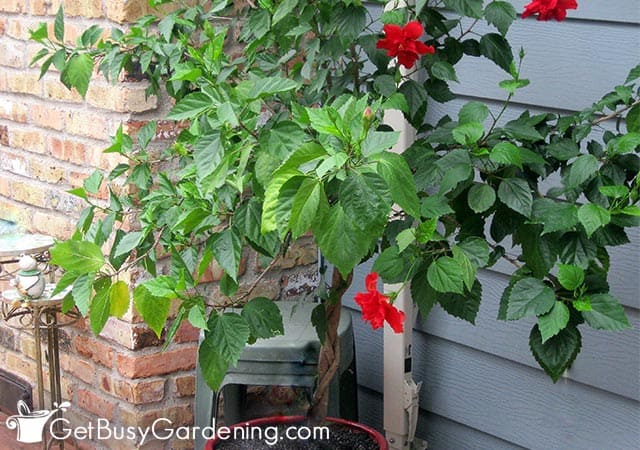
How To Overwinter Tropical Hibiscus
In this section, I’ll describe the three methods of overwintering hibiscus in detail. If you’ve never tried it, then I suggest choosing the technique that sounds most appealing to you, or experiment with a few of them.
Related Post: How To Overwinter Plants: The Complete Guide
1. Keeping Hibiscus As A Houseplant Through Winter
If your hibiscus is in a pot, then it’s easy to bring it indoors and keep it alive as a houseplant over the winter.
They aren’t too fussy, and don’t require much more care than your other houseplants. Just make sure to bring them in before the temperature drops below 60°F outside.
Depending on its size and the amount of space you have, you might want to cut it back first. You can prune the branches by as much as half without harming it.
Once inside, place it a warm spot near a sunny window. It’s common for them to go into a bit of shock after moving them in.
Some of the leaves and flower buds may turn yellow and drop off. This is normal, it’s just adjusting to the sudden change in environments. It should pop back in a few weeks.
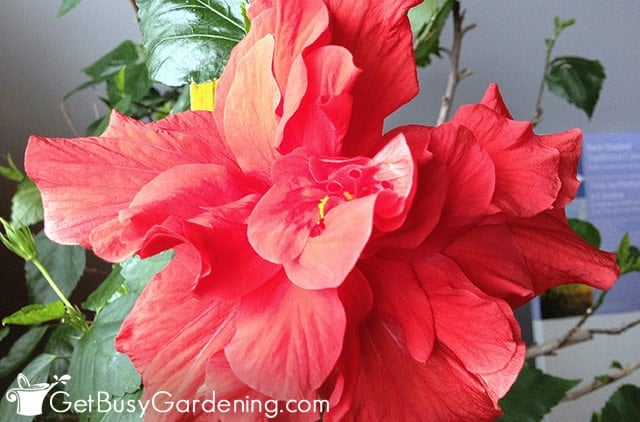
2. Overwintering A Dormant Hibiscus
Some people find it much easier to overwinter a dormant hibiscus, since you don’t have to worry about caring for a live plant.
If you want to try this, you can either wait until it naturally goes into hibernation on its own, or you can force it. Cool temperatures and drought are the main triggers.
To force dormancy, reduce the amount you water in the fall, and leave it outside until it gets down to 50°F. It will probably start dropping leaves and flowers, which is completely normal.
Once it gets too cold out, move it to a dark location inside the house. As it goes completely dormant, the rest of the leaves will eventually drop off.
Keep your dormant hibiscus in a dark and cool room through the winter, like your basement or a closet, and check on it once a month.
Water it very sparingly, and give it just enough to keep the soil from becoming bone dry.
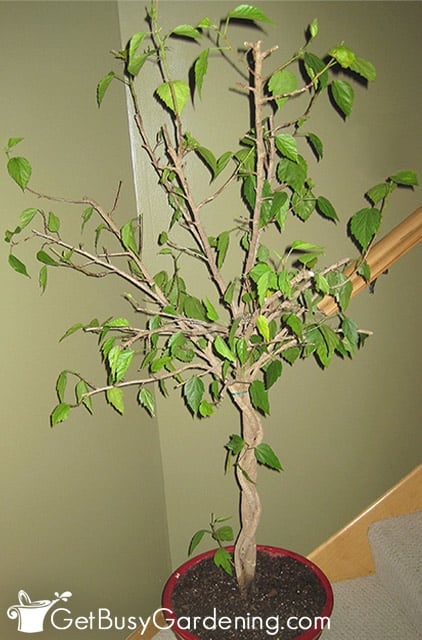
3. Wintering The Cuttings Indoors
If you don’t have the space for keeping or storing a hibiscus, you can try overwintering some cuttings instead.
Take your cuttings before it gets below 60°F outside for the best results. They should be about 4” long and include several leaves.
Remove the bottom leaves and place the stems into a container of water. Over time, they should develop roots. Once they do, you can either leave them in the water, or pot them up in fresh soil.
If you want to keep them in water, refresh it if it gets scummy or as it evaporates. The water should always be above the roots so that they don’t dry out.
Bringing Hibiscus Indoors For Winter
Whichever method you decide to use for overwintering hibiscus, it’s important to bring them indoors at the right time. Here’s how to do it so they’ll have no problem surviving until spring.
When To Bring Hibiscus Inside
If you plan to keep live plants or cuttings, then bring them inside before the temperature drops below 60°F. This usually happens several weeks before your average first frost date in the fall.
Otherwise, if you want to force dormancy, then leave it outside until it gets down to 50°F. Always make sure to bring them in before the first frost or they may not survive.
How To Bring Hibiscus In For Winter
Before bringing a live hibiscus in for winter, you should clean it first to get rid of any bugs. Follow these instructions for debugging potted plants.
You can use that same method for the cuttings, or do it inside. I soak mine in the sink filled with water and a little bit of mild liquid soap for 10 minutes, then rinse them well.
Once you’re done cleaning it, choose a location for it before bringing it in so you don’t have to move it again. Moving it around too much can cause further stress, which means it may drop more of its leaves.
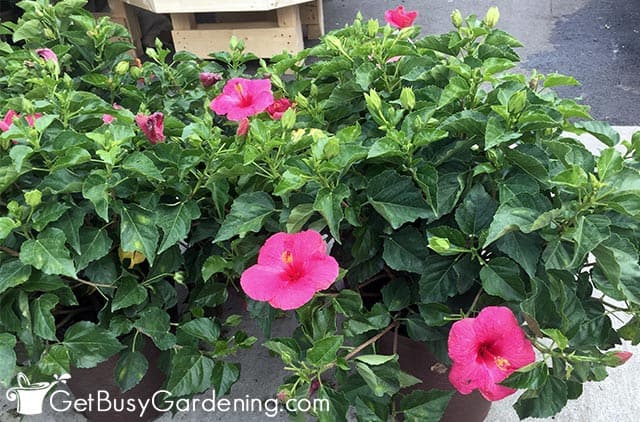
Hibiscus Winter Care Tips
Though it’s pretty easy to overwinter a live hibiscus, they will require some care to keep them thriving. They need adequate light and water, and you might also have to do some bug control.
Light Requirements
When you winter a potted hibiscus indoors, give it as much sunshine as you can, such as in front of a south-facing window. Ideally it should receive at least 6 hours of natural sunlight a day.
If you don’t have a sunny window, then you can use artificial lights instead. In that case, set them on a timer for about 16 hours a day.
When they get enough light, they will stay more compact, and might even bloom for you. Otherwise, they can start to get tall or leggy.
Watering In Winter
It’s best to keep the soil evenly moist through the winter, and never allow it to dry out completely. If they get too dry, they will start to droop and might even drop some leaves.
Take great care not to overwater though, as that can cause root rot and yellowing leaves. If you struggle to get it just right, use a soil moisture gauge.
They like humidity too, so you could also mist the leaves with lukewarm water once in a while, or run a humidifier nearby.
Controlling Bugs
One of the biggest challenges of overwintering hibiscus indoors is bugs. Mine are prone to being attacked by whiteflies, but other pests can also be a problem.
So it’s a good idea to check yours regularly for signs of pests. If you find any, begin treatment immediately to avoid infesting your other houseplants.
If yours becomes infested with flying insects, hang a yellow sticky trap from one of the branches to capture the adults.
For bugs on the leaves, mix 1 teaspoon of mild liquid soap per 1 liter of water, or use organic insecticidal soap to wash and spray the leaves. Neem oil is also very effective to control bugs.
Get all the details about how to grow them in my complete care guide.
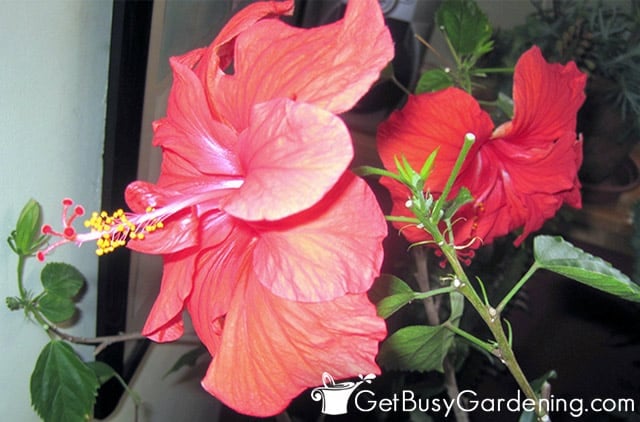
Bringing Hibiscus Out Of Dormancy
If you chose to let your hibiscus go dormant during the winter, follow these tips to wake it up and get it ready to bring back outside in the spring.
You can learn even more by reading my guide to bringing a plant out of dormancy.
When To Start Waking It Up
You can start to wake up your dormant hibiscus sometime in late winter. It’s best to begin breaking hibernation a month or two before your last frost date.
That way you’ll give it enough time to wake up slowly, and it will have plenty of time to get ready for life back outside. Here in MN, I start this process around February or March.
If you try to wake it up too fast, you could end up killing your plant, so it’s important to take your time. Keep in mind that it can take several weeks for them to show signs of life.
How To Break Dormancy
Start by moving your sleeping hibiscus out of the dark and placing it in a bright room. Don’t put it in direct sunlight though, filtered light is ideal.
Give it enough water to moisten the soil, but don’t overdo it. Over the next few weeks, keep the soil evenly moist and leave it where it is until you see the first new leaf buds.
Once that happens, give it a light dose (1/4 strength) of liquid fertilizer or compost tea. Adding slow-release granules will also help encourage healthy new growth.
Moving Hibiscus Back Outside After Winter
Moving a hibiscus outside after overwintering it indoors can be a bit tricky. You can’t just put it back in the same spot, it needs to get used to being outdoors again. Follow these tips for the best success.
When To Put Hibiscus Back Outside
It’s safe to put your hibiscus back outside in the spring when the overnight temperature stays above 60°F. I recommend waiting until after your last frost date to be safe.
If a late frost is in the forecast, then make sure to move it either back inside the house, or put it into the garage to protect it.
How To Move It Outside
Be careful when you bring your hibiscus outside. They need to be slowly acclimated to living back outdoors again.
Place it in a shady location at first, otherwise the direct sun can burn their tender winter leaves. Move them closer to a sunny spot each day for 10 days.
If you see any brown leaves or other signs of sunburn, move them back into the shade. After about two weeks they should be ready to sit in their final spot with plenty of direct sunlight.
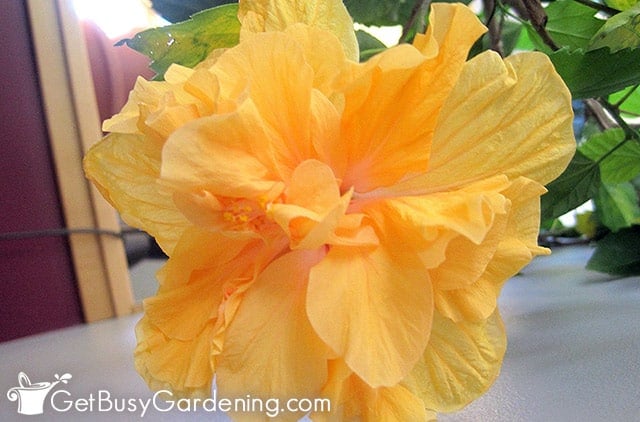
Overwintering Hibiscus FAQs
Here are some questions people often ask about overwintering hibiscus. If you don’t see an answer to yours here, please ask it in the comments below.
Can I overwinter hibiscus in the garage?
You can overwinter hibiscus in the garage as long as the temperature doesn’t dip below 50°F. If it’s not dormant, make sure to either place it near a window or use a grow light.
Can I overwinter a hibiscus in the basement?
Yes, you can overwinter a hibiscus in the basement, it’s the perfect place to store a dormant plant. You can even keep a live plant in your basement, as long as there’s a sunny window or you use a grow light.
How do you overwinter a potted hibiscus?
You can overwinter a potted hibiscus as either a live plant or in its dormant state. If you want to keep it alive, then put it near a sunny window or add a grow light. Otherwise, slow down on watering and let it go dormant, then place it in a cool, dark room through the winter.
Does hibiscus lose its leaves in winter?
Yes, a hibiscus will lose some of its leaves in the winter. If it goes dormant it will lose almost all of them.
Can I leave my hibiscus plant outside over winter?
You can leave your hibiscus outside over winter if it is hardy in your climate. Otherwise you must bring it inside in order for it to survive.
Do hibiscus bloom in winter?
Your hibiscus can bloom in winter if you care for it correctly. Give it at least 6 hours of natural sunlight, or 12-16 hours of artificial light every day.
Overwintering hibiscus is easy enough for even beginners, and it’s fun too. It can save you time and money next spring, and you may even get to enjoy their showy blossoms all winter long.
If you want to learn all there is to know about maintaining healthy indoor plants, then you need my Houseplant Care eBook. It will show you everything you need to know about how to keep every plant in your home thriving. Download your copy now!
More About Overwintering Plants
- How To Overwinter Pepper Plants Indoors
- Overwintering Begonias: Storing The Tubers Or Keeping Live Plants
- How To Overwinter Brugmansia (Angel’s Trumpet)
- How To Overwinter Plumeria (Frangipani) Plants Indoors
Have you ever tried overwintering hibiscus? Share your tips in the comments section below.


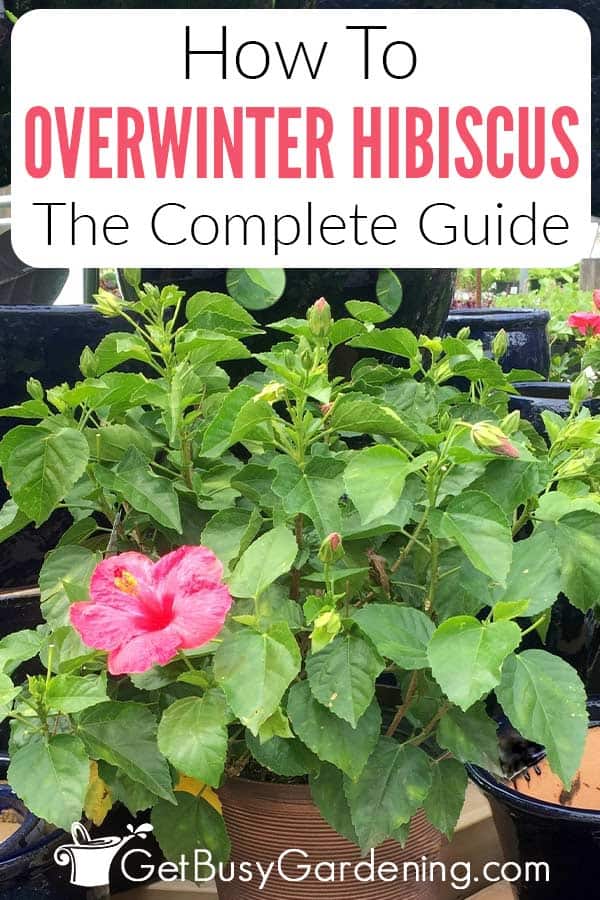



Kenneth E Paulsen says
MY PLANT IS DOING VERY WELL AFTER OVERWINTERING.
HOW SOON WILL START FLOWERING?
KEN
Amy Andrychowicz says
Great to hear that your hibiscus has survived the winter indoors and is doing great! It should start blooming shortly after the leaves fill in. You may need to give it more light and/or some fertilizer. Here’s my detailed hibiscus plant care guide for more information.
Janet Levy says
I have two hibiscus that I that I have been wintering inside; this is their third winter. Last winter, they kept all their leaves and I was careful to acclimate them slowly when putting them outside for the summer. I repotted one of them and pruned them slightly in spring.. Both did fine all summer but never bloomed! I was feeding them regularly and they were in full sun. I wanted to know if there is something I can do to get them to bloom this summer. After all, that’s their job as a hibiscus, isn’t it? I tell them they need to give me something back for all my hard work to keep them alive. I welcome any advice. Thanks.
Amy Andrychowicz says
There are a few reasons why your hibiscus might not have flowered. Mainly too much shade (they need at least 6 hours of full sun in order to bloom), inadequate watering (keep the soil evenly moist, and never soggy or completely dry), pruning too late in the spring (cut them back as soon as they break dormancy), or using the wrong type of fertilizer (make sure it’s a one high in potassium). You can read my full hibiscus care guide for more information.
Aparecida says
I live in zone 7 every year my hibiscus tupiaras only start to bloom in the beginning of fall when it’s almost time to bring them indoor. I trimmed them when bring them indoor when I transplant them to smaller pot.
I fertilize them with proper fertilizer, for hibiscus. I fell so frustrated. Also, I make a rad prune. Should it be slightly prune or instead of pruning on fall should it be in early spring before take them outside? Appreciate if you can help me!
Amy Andrychowicz says
Yes, I would definitely recommend that you wait to both prune and repot your hibiscus until the spring. If you prune it just as it’s starting to bloom in the fall, you’re just cutting off all of the future flowers. Repotting in the fall is also not good for them as it can cause stress, which leads to bud and flower drop. You also shouldn’t fertilize your hibiscus in the fall or the winter, as that will trigger weak, leggy growth and further stress them. Wait until spring to start fertilizing again. Here’s my complete guide for how to care for hibiscus plants that will give you more information.
Dennis Ellis says
I dug up my Hibiscus and placed it inside in a pot in early November (Toronto). At the time it was still flowering and looking luscious. Since then it has started losing leaves. I am afraid that it will die. The stem isn’t looking green anymore. Any advice?
Amy Andrychowicz says
Oh no, sorry to hear your hibiscus is struggling. They are notorious for losing leaves when you move them from being outside to indoors, they don’t like the change and it’s a pretty big adjustment for them. On top of that, repotting is also a big stressor, so doing both at the same time is definitely going to cause some pretty severe shock. It’s normal for them to drop their leaves when you bring them indoors for the winter, and it can take a few weeks for them to adjust and recover. However, if it has lost all of its leaves, then it’s likely gone dormant. But you can overwinter your hibiscus in either its dormant state, or as a live plant. If it still has several leaves, then you can try keeping it alive through the winter. In that case, the best thing to do is put it near a sunny window, and maintain the soil on the dry side, taking great care not to overwater.
Shawna says
Hi I never had a large hibiscus before I have 3 and several small ones anyway I took them indoors did everything right sprayed before with oil for bugs and stopped fertilizer but one kept some leaves other two lost them I have them In a front window also with lights around them cuz I have other plants as well under lights and I accidentally fertilize the two tall ones by mistake one day when I was fertilizing the rest of the plants and then I just kept fertilizing them because I didn’t know what to do. I noticed that they started growing their leaves again on one of them but the other one I did in fertilize. Anyway, now I don’t know what to do. Do I stop fertilizing again and let their leaves fall or do I keep fertilizing? Am I going to kill the plants because I love them so much. I don’t know what to do
Amy Andrychowicz says
Definitely stop fertilizing your hibiscus and let them recover, then don’t feed them at all during the winter. (In fact, you shouldn’t be feeding any of your plants during the colder months, unless they’re winter bloomers). Winter is their rest period and giving them fertilizer will cause weak and leggy growth and stress the plant. Keep the soil on the dry side, give them plenty of light, and let them recover from the shock of being moved inside.